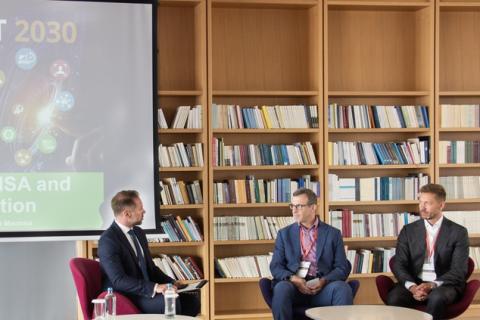The European Union Agency for Cybersecurity (ENISA) organised the 2024 edition of the ‘Threathunt 2030’ in Athens, the flagship conference on cybersecurity threats foresight.
‘Threathunt 2030’ returned to highlight the significance of advanced foresight in prevention and response efforts towards emerging cybersecurity and hybrid threats. Through a series of interactive panels, ENISA addressed various aspects of foresight in the area of cybersecurity threats, with a view to improve resilience and security across the EU.
EU Agency for Cybersecurity Executive Director, Juhan Lepassaar highlighted that: “Especially for 2024, foresight is key for cybersecurity strategic planning. Technological evolution, the current geopolitical situation, along with the cybersecurity landscape call for preparedness against anticipated or not-anticipated challenges and threats.”.
Over time, the ENISA Threat Landscape has served as a crucial tool for understanding the present state of cybersecurity within the EU, furnishing insights into trends and patterns. This, in turn, has guided pertinent decisions and prioritisation of actions and recommendations in the domain of cybersecurity. Based on that statement, Threathunt 2030 discussions explored the interlink between geopolitical developments and the emergence of new threat actors and targets.
The first panel of the Threathunt2030 aimed to shed some light on how EU Member States and the EU can boost their capacity to prevent, deter and respond to cyber threats and attacks in the run up to 2030. It also examined what would be the role of ENISA in short and long-term planning of related strategies.
The second panel explored the role and influence of AI (artificial intelligence) and PQC (post quantum computing) and tried to identify the most pressing AI and PQC driven cybersecurity threats.
The third round of discussions consisted of a fireside chat between the Executive Assistant Director of CISA, Jeff Greene and the ENISA Executive Director, Juhan Lepassaar elaborating on the cooperation between CISA and ENISA and how it could be streamlined in the best possible way. The goal is to accommodate common needs of USA and EU and to harmonise relevant initiatives.
The panel titled “2030: Scenarios around the world” focused on the possible future developments in the cyber threat landscape as a consequence of geopolitics in the next 5 years.
The last panel, consisting of the three influential cybersecurity agencies, examined the ways to incorporate foresight and long-term strategic thinking into all involved current cybersecurity frameworks to better prepare for future threats. In this context, panelists examined whether the use of foresight can actually become a key driver of change for governments and cybersecurity policy initiatives.
As a conclusion, it is fundamental to learn from the past, to take advantage of the opportunities of the present and to prepare for the future.
You may find additional photos from the conference here.
Did you know that ENISA published the 2024 Threat Landscape Report?
This year the publication of the annual ENISA Threat Landscape report coincided with the ‘Threathunt 2030’ conference, making a significant contribution to the discussion. Prominent cybersecurity threat groups identified through analysis were ransomware and malware, social engineering, threats against data and threats against availability (Denial of Service), information manipulation and interference, along with supply chain attacks.
For another year, DDoS and ransomware attacks lead in the rankings as the most reported forms of attacks, accounting for more than half of the observed events. It is notable that, compared to last year’s findings, there was an inversion in the rankings, with DDoS attacks moving to first place and ransomware dropping to second. ETL 2024 is based on and analyses more than 11,000 incidents in total. The sectorial analysis conducted revealed that the most target sector was Public Administration (19%), followed by Transport (11%).
Further Information
Foresight Cybersecurity Threats For 2030 - Update 2024: Executive Summary — ENISA (europa.eu)
Foresight Cybersecurity Threats For 2030 - Update 2024: Extended report — ENISA (europa.eu)
Skills shortage and unpatched systems soar to high-ranking 2030 cyber threats — ENISA (europa.eu)
Threathunt 2030: How to Hunt Down Emerging & Future Cyber Threats — ENISA (europa.eu)
Contact
For press questions and interviews, please contact press (at) enisa.europa.eu
For foresight questions, please contact foresight (at) enisa.europa.eu





